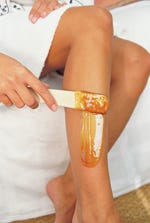February 26, 2011

For many natural products shoppers, letting their body hair grow naturally seems like a great idea until they put on a strapless dress or bikini. And yet they don’t want to nurture the hair on their head with organic shampoo and then zap unwanted body hair with chemical creams and waxes. They’re looking for hair-removal products that are as natural as everything else in your store. Fortunately, more companies are now producing natural razors, shaving creams and gels, waxes and sugars. Here’s what you and your customers should know about the most effective, natural ways to defuzz.
 Shaving
Shaving
Conventional options: Many mainstream shaving creams rely on sodium lauryl or laureth sulfates to create lather, says Emma Mann, director of marketing for Corte Madera, Calif.-based personal care company EO Products. Both types of SLS can irritate skin, according to the Environmental Working Group, a nonprofit watchdog organization. Other harsh ingredients include stearic acid, a lubricant that the EWG links to cancer and nervous-system problems, the chelating agent EDTA and parabens—preservatives that may cause reproductive issues.
Natural alternatives: Stock shaving creams that use natural sudsing agents such as coconut oil (look for ingredients that start with coca, like cocamidopropyl hydroxysultaine), or point customers to gels. Neal Schultz, MD, a New York City cosmetic dermatologist, says gels help razors glide better than do creams or foams. Another option: creams that include jojoba or other oils to reduce friction and moisturize skin. Cetearyl olivate, a fatty acid derived from olive oil, is a natural alternative to stearic acid, and essential oils do double duty as preservatives and skin nourishers. You can also supply eco-friendly shaving tools: Waltham, Mass.-based Preserve makes razors with 100 percent recyclable plastic handles derived from yogurt cups.
Tips for customers: For less irritation, Schultz recommends shaving at the end of your shower, after the steam has softened your skin. Wash the areas you’re going to shave to remove the oil and help the steam penetrate, and shave in the direction your hair grows (from knee to ankle, for instance).
Waxing and sugaring
Waxing
Conventional options: Some waxes are made from paraffin, which contains petrochemicals, says Janet Chao, marketing director with Parissa Labs, a Vancouver-based manufacturer of natural waxes. Conventional waxes may also contain parabens and artificial colors and fragrances. The EWG notes that some artificial colors contain carcinogens, and artificial fragrances may include phthalates, which can disrupt the endocrine and reproductive systems.
Natural alternatives: Look for waxes made from pine resin or soy—beeswax or honey-based waxes don’t remove hair as well, says Katherine Goldman, an aesthetician and owner of Stript Wax Bar in San Francisco. Some natural waxes may also contain oils, like castor oil, to help make the wax more spreadable, Chao says.
Tips for customers: Alley Laundry, “waxing guru” at Parissa Labs, says the proper technique—quickly ripping off the wax parallel to the skin rather than yanking upward, which pulls the skin—can prevent bruising and reduce 90 percent of the pain. Azulene oil, made from chamomile, can reduce post-waxing irritation.
Sugaring
Conventional options: Sugaring remains a natural technique that hasn’t yet caught on with mainstream manufacturers.
Natural alternatives: Sugaring is basically another type of waxing. Laundry says the formula—sugar, water and lemon juice—dates back to ancient Egypt, and is cooked into a taffylike consistency that sticks to hair. It’s spread on with hands or a tongue depressor and pulled off with fabric strips.
Tips for customers: Sugaring isn’t for everyone. Because the mixture isn’t as sticky or powerful as wax, sugaring works best on fine to medium hair, Chao says. But that gentleness also makes it good for sensitive skin. Another benefit: Sugar is easier to wipe off than wax, which needs to be removed with oil.
About the Author(s)
You May Also Like
.png?width=700&auto=webp&quality=80&disable=upscale)




